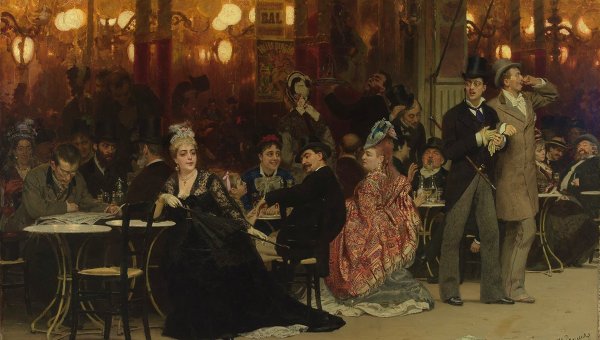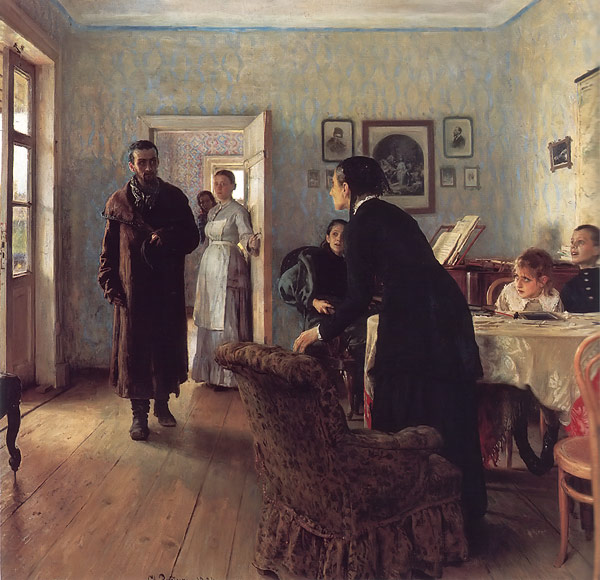Hard to believe people are willing to invest so deeply in art that is almost bereft of any importance. Strictly a commodity with exchange value? Perhaps. Clement Greenberg was likely too harsh on Repin, although he was correct in questioning what is really the phantom element of psycho-social tension within the work, which appears pre-fabricated and contrived. But, even if it is false work, it is still the kitsch of genius which in a sense is tragic to waste talent on drivel, maudlin Russian romanticism. Perhaps there is no such thing as a Russian soul and he was doing the best he could with the raw material at hand. Then, there is not much difference between Repin’s socialist realism and Frith’s Derby Day or George Hicks and The Post Office. All in the same dump bin end cap.

---A painting by Russian artist Ilya Repin, Parisian Cafe, was sold for 4.5 million pounds (around $7.3 million) at the Christie's Russian Art sale in London, breaking the previous record of Svyatoslav Roerich's canvas sold at the auction house for $3 million, Christie's press service said. Painted in Paris in 1875, Parisian Cafe was inspired by French impressionism and the Parisian atmosphere while Repin was studying Fine Arts in France and Italy. The canvas has remained in a distinguished private collection since 1916 and was displayed in Russia only once, at Christie's pre-auction exhibition in April 2011.--- Read More:http://en.rian.ru/art_living/20110606/164476792.html
Where Greenberg trips up, is the overrating of abstract art, which soon became a symbol of American imperialism, a flagship brand peddled like Coke or agricultural equipment. Picasso paved the way for Warhol, through a dissection of the figure, an abandon that was nihilistic, negating and charged with rage. No dignity. No empathy. Contemptuous of the human figure. Malevolent. Ghosts in a formalized machine. Warhol just added some irony to an existing endorsement of the consumer culture it ostensibly criticized. Picasso created indifferent art that provided insight into our consumer society and the cheapness of life. In this light the faithful realism of Repin is more digestible.
Greenberg: he quotes the following from Kurt London’s The Seven Soviet Arts: “. . . the attitude of the masses both to the old and new art styles probably remains essentially dependent on the nature of the education afforded them by their respective states.” Macdonald goes on to say: “Why after all should ignorant peasants prefer Repin (a leading exponent of Russian academic kitsch in painting) to Picasso, whose abstract technique is at least as relevant to their own primitive folk art as is the former’s realistic style? No, if the masses crowd into the Tretyakov (Moscow’s museum of contemporary Russian art: kitsch), it is largely because they have been conditioned to shun ‘formalism’ and to admire ‘socialist realism.’”…
…He turns next to Repin’s picture and sees a battle scene. The technique is not so familiar — as technique. But that weighs very little with the peasant, for he suddenly discovers values in Repin’s picture that seem far superior to the values he has been accustomed to find in icon art; and the unfamiliar itself is one of the sources of those values: the values of the vividly recognizable, the miraculous and the sympathetic. In Repin’s picture the peasant recognizes and sees things in the way in which he recognizes and sees things outside of pictures — there is no discontinuity between art and life, no need to accept a convention and say to oneself, that icon represents Jesus because it intends to represent Jesus, even if it does not remind me very much of a man. That Repin can paint so realistically that identifications are self-evident immediately and without any effort on the part of the spectator — that is miraculous. The peasant is also pleased by the wealth of self-evident meanings which he finds in the picture: “it tells a story. ” Picasso and the icons are so austere and barren in comparison. What is more, Repin heightens reality and makes it dramatic: sunset, exploding shells, running and falling men. There is no longer any question of Picasso or icons. Repin is what the peasant wants, and nothing else but Repin. It is lucky, however, for Repin that the peasant is protected from the products of American capitalism, for he would not stand a chance next to a Saturday Evening Post cover by Norman Rockwell….
…Where Picasso paints cause, Repin paints effect. Repin predigests art for the spectator and spares him effort, provides him with a shore cut to the pleasure of art that detours what is necessarily difficult in genuine art. Repin, or kitsch, is synthetic art…. Read More:http://www.sharecom.ca/greenberg/kitsch.html









 COMMENTS
COMMENTS



